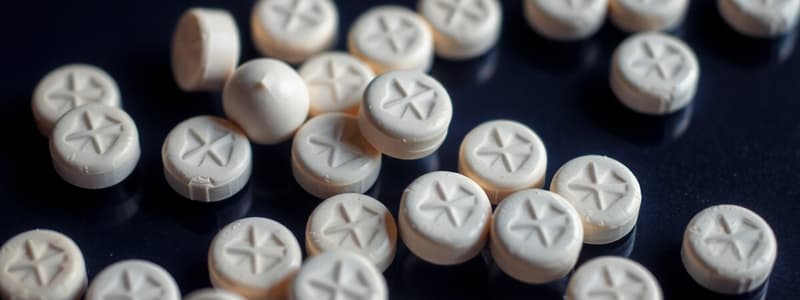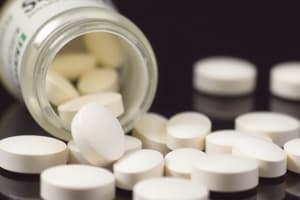Podcast
Questions and Answers
SGAs cause sexual dysfunction more frequently than FGAs.
SGAs cause sexual dysfunction more frequently than FGAs.
False (B)
FGAs have a significantly higher risk of tardive dyskinesia compared to SGAs.
FGAs have a significantly higher risk of tardive dyskinesia compared to SGAs.
True (A)
Paliperidone palmitate is associated with more weight gain and changes in prolactin than low-dose haloperidol decanoate.
Paliperidone palmitate is associated with more weight gain and changes in prolactin than low-dose haloperidol decanoate.
True (A)
Lower doses of FGAs completely eliminate the risk of tardive dyskinesia.
Lower doses of FGAs completely eliminate the risk of tardive dyskinesia.
The efficacy of paliperidone palmitate is different from that of haloperidol decanoate.
The efficacy of paliperidone palmitate is different from that of haloperidol decanoate.
First-generation antipsychotic medications were introduced after 1990.
First-generation antipsychotic medications were introduced after 1990.
Second-generation antipsychotics are always expected to have fewer adverse effects related to extrapyramidal symptoms.
Second-generation antipsychotics are always expected to have fewer adverse effects related to extrapyramidal symptoms.
Haloperidol has a therapeutic index narrow enough to limit extrapyramidal symptoms at doses between 4.0 and 4.5 mg/day.
Haloperidol has a therapeutic index narrow enough to limit extrapyramidal symptoms at doses between 4.0 and 4.5 mg/day.
Depot preparations of antipsychotics are rarely prescribed despite their effectiveness.
Depot preparations of antipsychotics are rarely prescribed despite their effectiveness.
Chlorpromazine and haloperidol are listed as common first-generation antipsychotics for managing schizophrenia.
Chlorpromazine and haloperidol are listed as common first-generation antipsychotics for managing schizophrenia.
FGAs are less effective than all non-clozapine SGAs.
FGAs are less effective than all non-clozapine SGAs.
Acute extrapyramidal symptoms and hyperprolactinaemia are common side effects associated with FGAs.
Acute extrapyramidal symptoms and hyperprolactinaemia are common side effects associated with FGAs.
The therapeutic index does not vary between different antipsychotic drugs.
The therapeutic index does not vary between different antipsychotic drugs.
Flashcards are hidden until you start studying
Study Notes
SGAs and FGAs
- Some SGAs cause sexual dysfunction.
- SGAs such as risperidone, paliperidone, and amisulpride increase prolactin more than FGAs.
- All FGAs are potent dopamine antagonists, potentially inducing dysphoria.
- FGAs may have smaller benefits in quality of life than some SGAs.
Tardive Dyskinesia (TD)
- TD is more frequent with FGAs than SGAs.
- FGA atypicality is difficult to define.
- Lower FGA doses may reduce TD risk.
- Partial agonist SGAs have varied impacts on TD risk.
- Effective monitoring and prescribing are crucial to minimize TD risk.
Comparative Trial Insights
- A study compared paliperidone palmitate with low-dose haloperidol decanoate:
- Paliperidone resulted in more weight gain and prolactin changes.
- Haloperidol was associated with increased akathisia and parkinsonism.
- Efficacy was identical between treatments.
First-Generation Antipsychotics – Place in Therapy
- First-generation (“typical”) and second-generation (“atypical”) antipsychotics are not clearly differentiated.
- Both groups have diverse pharmacological and side-effect profiles.
- First-generation medications (pre-1990) are linked to:
- Acute extrapyramidal symptoms (EPS)
- Hyperprolactinaemia
- Tardive dyskinesia (TD)
- Second-generation medications (post-1990) were expected to have fewer EPS adverse effects.
- This is not consistently true for all SGAs and FGAs.
- SGAs and FGAs are associated with metabolic and cardiac complications.
Key Points
- Therapeutic and adverse effects of FGAs are differentiated by careful dosing.
- The therapeutic index varies between drugs, impacting side effect incidence.
- Haloperidol has a narrow range (4.0 to 4.5 mg/day) with minimal EPS.
- Olanzapine has a broader range (5 to 40 mg/day) with fewer EPS.
- Neuroscience-based Nomenclature (NbN):
- Classifies drugs based on pharmacological activity.
- Enhances understanding of individual drug options.
Role of Older Antipsychotics
- FGAs are essential in schizophrenia management:
- Common options include chlorpromazine and haloperidol for PRN (as needed) medication.
- Depot preparations of haloperidol, zuclopenthixol, and flupentixol are regularly prescribed.
- FGAs can be an alternative to poorly tolerated SGAs due to metabolic changes.
- Some FGAs may be slightly more efficacious than non-clozapine SGAs (e.g., amisulpride, olanzapine, risperidone), but efficacy differences appear modest.
Drawbacks of FGAs
- Common adverse effects:
- Acute EPS
- Hyperprolactinaemia
- Efficacy risks are close to causing adverse effects, potentially affecting sexual function and hypothalamic function.
Studying That Suits You
Use AI to generate personalized quizzes and flashcards to suit your learning preferences.



